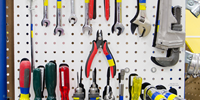
Understanding 5S Methodology in Lean Manufacturing
In Lean Manufacturing, the 5S methodology stands as a fundamental pillar driving efficiency, organisation, and productivity within workplaces. Originating from Japan and rooted in the five-step process of Sort, Set in order, Shine, Standardize, and Sustain, 5S is more than just a tool for tidying up—it's a philosophy that cultivates a culture of continuous improvement and operational excellence.
Unpacking the 5S Methodology
1. Sort (Seiri): The first step entails decluttering and removing unnecessary items from the workspace. By eliminating what is not needed, organisations can streamline processes, reduce waste, and optimise space utilization.
2. Set in Order (Seiton): This phase focuses on arranging essential items in a structured and efficient manner. Visual management techniques like labelling, colour coding, and designated storage locations enhance accessibility, minimising search time and improving workflow.
3. Shine (Seiso): Maintaining cleanliness and hygiene is at the core of this step. Regular cleaning of work areas not only ensures a safe and pleasant environment but also reveals abnormalities that might indicate underlying issues affecting operations.
4. Standardise (Seiketsu): Standardisation involves establishing consistent practices and protocols across the organisation. By setting clear guidelines and procedures, companies foster a culture of uniformity, reliability, and quality in their processes.
5. Sustain (Shitsuke): Sustainability is key to the longevity of 5S principles. Encouraging discipline, ownership, and continuous improvement ensures that the gains achieved through the first four steps are maintained over time, becoming ingrained in the organisational culture.
The Impact of 5S on Operations
Implementing the 5S methodology yields a myriad of benefits for organisations, including:
- Enhanced efficiency and productivity through optimised workflows.
- Improved workplace safety and morale by promoting cleanliness and orderliness.
- Reduction in operational downtime and delays due to standardised processes.
- Increased employee engagement and empowerment as teams take ownership of their workspaces.
- Cost savings resulting from decreased waste and improved resource utilisation.
Embracing 5S for Long-Term Success
As businesses navigate the complexities of modern manufacturing environments, embracing the principles of 5S can pave the way for sustainable growth, operational excellence, and a culture of continuous improvement. By instilling discipline, organisation, and a commitment to excellence through the 5S methodology, companies can drive efficiency, foster innovation, and thrive in an increasingly competitive landscape.
In conclusion, 5S is not just a methodology—it's a transformative approach that empowers organisations to unlock their full potential, elevate operational standards, and embark on a journey towards excellence in every facet of their operations.
